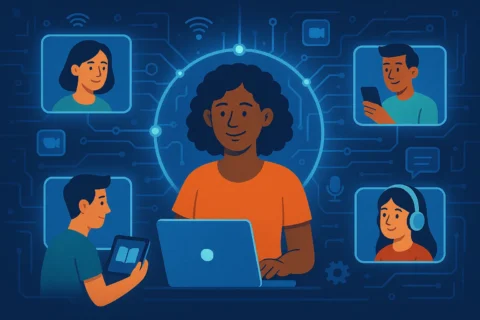Teaching online has grown rapidly in recent years, driven by advances in digital platforms and changing global needs. It’s moved from being a niche option to a core part of ELT. For many teachers, it’s now a question of how to balance online and in-class work rather than choosing one or the other. The two modes do feel different, in ways that affect everything from preparation to classroom management.
If you’ve only ever taught face to face, you might be wondering what changes when you go online. And if you’ve only taught online, you might be curious about what the traditional classroom adds. Here’s a practical look at the main differences, plus the pros and cons for teachers and students.
This guide is based on my 20+ years of classroom and teacher training work, together with my own experience teaching English online and supporting teachers as they move into digital classrooms.
Key differences between online and in‑class teaching
1. Location and accessibility
Online: Classes can happen anywhere there’s a decent internet connection. Teachers might be working from a home office or while travelling, while students can log in from their bedroom or kitchen table. For learners in remote areas or with mobility issues, this flexibility is a game-changer.
In-class: Lessons require everyone to be physically present in the same space – a language school, university, or training centre. The upside is a stronger sense of “being together,” but the downside is less flexibility. Travel delays, strikes, or bad weather can all get in the way.
2. Interactivity and engagement
Online: Interaction happens through screens, with tools like breakout rooms, polls, and chat boxes. These can be powerful but don’t always feel as natural as spontaneous talk in a classroom. A muted mic or shaky connection can interrupt the flow, so engagement needs to be deliberately designed.
In-class: Face-to-face teaching has a built-in advantage here. Students can turn to a partner instantly, pick up on body language, and feed off the energy of the room. Teachers can adapt on the spot when learners look confused or inspired.
3. Flexibility, working hours, and pay
Online: Freelancers often set their own schedules, which is attractive, but peak demand may fall at inconvenient hours. A teacher in Europe working with Chinese students may find themselves teaching early mornings or late evenings. Pay is also inconsistent, with few jobs offering benefits.
In-class: Jobs usually follow a fixed timetable. While you lose some flexibility, you gain stability. Salaries are often steadier, and contracts may include benefits such as paid holidays or professional development opportunities.
4. Technology and digital literacy
Online: Tech is central to everything. Teachers need to be confident with video platforms, screen sharing, and troubleshooting when things go wrong. For students, digital literacy becomes part of the learning process – useful, but sometimes an extra hurdle.
In-class: Technology can enrich lessons, but it isn’t essential. A board and a coursebook are often enough. Digital literacy isn’t required to the same extent.
5. Social interaction and support
Online: Social contact exists but has to be consciously built in through warmers, projects, or group chats. Without it, lessons risk feeling transactional, and both students and teachers can feel isolated.
In-class: Social interaction happens naturally – before, during, and after lessons. Teachers also have colleagues to share ideas with and to lean on for support.
6. Lesson preparation
Online: Some platforms provide ready-made lessons, cutting preparation time. Freelancers, however, need to adapt or create their own, while also making sure slides, links, and tools are ready to go.
In-class: Preparation often means adapting a coursebook and creating physical resources. Teachers might bring in realia, cut up role cards or flashcards, or plan activities involving movement around the room.
7. Classroom management
Online: Behaviour issues are usually minimal, especially one-to-one, but keeping students engaged can be harder. A switched-off camera or connection problem can quickly break the rhythm.
In-class: Behaviour management is more visible in larger groups, but teachers have more tools at their disposal. Proximity, eye contact, and tone of voice work instantly in ways that aren’t possible online.
Pros and cons for teachers and students
Teachers – online
For teachers, online work brings a lot of freedom. You can work from home or while travelling, set your own schedule, and avoid the cost and time of commuting. Some platforms provide full lesson plans, which reduces preparation, and freelancers can sometimes charge high hourly rates.
But there are downsides too. Income is often unpredictable, contracts rarely include benefits, and your busiest hours may be early morning or late evening depending on time zones. Online teaching can also feel isolating, with long hours in front of a screen, fewer colleagues to talk to, and limited career progression. And of course, the ever-present risk of a shaky internet connection disrupting your lesson.
Teachers – in-class
In-class teaching tends to be more stable. Salaries are usually fixed, contracts may include paid holidays and professional development, and the timetable is predictable. You’re also part of a staffroom community, with colleagues to share ideas and frustrations with.
On the other hand, you lose much of the flexibility that online teaching offers. Daily commutes can eat into your time and energy, and you have less freedom to adjust your schedule. Preparation may also take longer if you’re adapting coursebooks or creating physical resources.
Students – online
For students, the advantages are equally clear. They can learn from anywhere, often more cheaply than in person, and schedule lessons to fit around their lives. Many platforms record sessions or provide materials that students can revisit later, which can boost learning. They also pick up useful digital skills as they go.
On the other hand, studying online requires self-discipline and motivation – and not everyone thrives in a home environment. Some students miss the buzz of learning in a group, while others struggle with the technology itself. Ultimately, their experience depends a great deal on how engaging and well-structured the teacher makes each lesson.
Students – in-class
In-class learners benefit from a strong sense of community. They meet peers face to face, form friendships, and practise language in a more natural social setting. Teachers can read their body language and respond immediately, making support more personalised.
At the same time, in-class study can be less convenient. Students have to travel, commit to fixed schedules, and often pay higher course fees. For some, those barriers make regular attendance difficult, even if the in-person experience is richer once they’re there.
So, which is better?
Neither format is automatically “better” – they simply shape the teaching and learning experience in different ways. Online teaching offers flexibility and reach; in-class teaching offers immediacy and community. Many teachers now do both to get the best of each world.
If you’re moving online, don’t think of it as starting from scratch. The fundamentals of good teaching – clear objectives, engaging tasks, constructive feedback – remain the same. You’re simply adapting them to a different space.
Read next: Ready for the “how”? Read How to Teach English Online Effectively: Strategies, Tools, and Tech Setup for step-by-step techniques you can apply right away.
Thinking about building your skills for both online and in-person teaching? Take a look at our Online TEFL Course with full tutor support.





